Two for One...
Two countries, both influenced by the Russians, which have come out of ruin and have rebuilt or are rebuilding their bright new futures. I can't believe how much the Russians have influenced these countries and how far their reign stretched. Even Tallinn in Estonia and the Ukraine back in the Black Sea have their roots deep into Russian heritage, but have become independent of this huge empire. Finland and Germany have risen out of the rubble of devastation and created beautiful cities rich in history.
Helsinki, Finland (originally founded by the Swedes in 1550 by Gustav Vasa). I've seen it now at least 4 times on this Baltic cruise. It's normally a day of leisure and occasionally exploration. Over these 4 visits, I've seen quite a bit and just thought I'd summarize. It's the land of Santa Claus. Lapland in northern Helsinki seems to be a popular tour running for about $700 since it involves a flight to the Arctic Circle. Lapland is about 1/3 of Finland itself and is the land of the midnight sun. Someday I'd like to visit this place JUST to see it.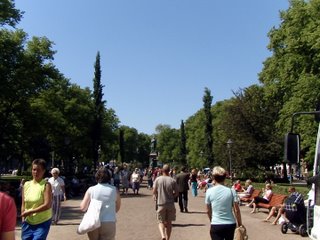 Santa Claus is the icon here because of the reindeer. Yes folks, reindeer. The Lapps raise them up here and these Lapps are most famous for their traditional garb. One day, I do plan to make that North Pole visit and relive my childhood fantasy of meeting the REAL Santa Claus (or at least a Lapp dressed in traditional garb with a few reindeer). We dock in Helsinki, which is Finland's capital since 1812. The southern coast of Finland is the most populated, industrialized and the richest part of the country. Its Russian neighbor derived its very shape and form. Following a devastating fire in 1808 and its appointment as the capital in 1812, Helsinki was rebuilt with wide streets and neoclassical brick buildings modeled after the Russian capital of St. Petersburg.
Santa Claus is the icon here because of the reindeer. Yes folks, reindeer. The Lapps raise them up here and these Lapps are most famous for their traditional garb. One day, I do plan to make that North Pole visit and relive my childhood fantasy of meeting the REAL Santa Claus (or at least a Lapp dressed in traditional garb with a few reindeer). We dock in Helsinki, which is Finland's capital since 1812. The southern coast of Finland is the most populated, industrialized and the richest part of the country. Its Russian neighbor derived its very shape and form. Following a devastating fire in 1808 and its appointment as the capital in 1812, Helsinki was rebuilt with wide streets and neoclassical brick buildings modeled after the Russian capital of St. Petersburg.  Senate Square is dominated by the recently renovated Tuomiokirkko, which is now mostly used for exhibitions. It stands on a platform above the square and has within its architecture the glories of ancient Greek and Roman influences. It's quite the sight to see among the hip shops that comprise the entire area.
Senate Square is dominated by the recently renovated Tuomiokirkko, which is now mostly used for exhibitions. It stands on a platform above the square and has within its architecture the glories of ancient Greek and Roman influences. It's quite the sight to see among the hip shops that comprise the entire area.  Malls, pubs, restaurants, and trendy hangouts dominate the new city.
Malls, pubs, restaurants, and trendy hangouts dominate the new city. 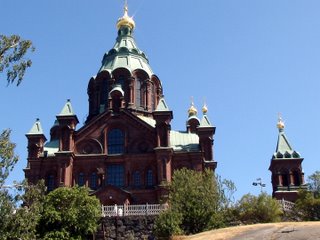 Down the street and east is the Russian Orthodox Upensky Cathedral. You can see this structure from the Esplanadi sitting high up on it's perch just past the open market by the water. The Esplanadi is the hangout area. There are festivals in the park that runs down the middle of two streets. On either side are various street cafes, restaurants, pubs, and trendy stores. At the end of the boulevard is an open-air market selling anything from fresh vegetables and meats to trinkets and souvenirs. One day I took a walk around the great park that sits behind the train station here and the people are just so care free. It was the middle of the week and the middle of the day and people were on the lawns sunbathing and reading books. How do they do it? I also ventured off with a group to Temppeliaaukio Church (or the Church in a Rock).
Down the street and east is the Russian Orthodox Upensky Cathedral. You can see this structure from the Esplanadi sitting high up on it's perch just past the open market by the water. The Esplanadi is the hangout area. There are festivals in the park that runs down the middle of two streets. On either side are various street cafes, restaurants, pubs, and trendy stores. At the end of the boulevard is an open-air market selling anything from fresh vegetables and meats to trinkets and souvenirs. One day I took a walk around the great park that sits behind the train station here and the people are just so care free. It was the middle of the week and the middle of the day and people were on the lawns sunbathing and reading books. How do they do it? I also ventured off with a group to Temppeliaaukio Church (or the Church in a Rock). 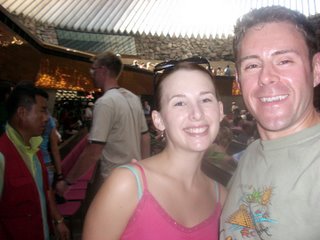 It was built into solid rock and consecrated in 1969. It's superb acoustics allow it to be used for many great concerts. About 90% of these buildings were built after 1920 due to the fire and the harsh struggles between Sweden and Russia. Yet another beautiful place to take a casual stroll and let the woes of the world roll off, as most of these people seem to be doing in the parks.
It was built into solid rock and consecrated in 1969. It's superb acoustics allow it to be used for many great concerts. About 90% of these buildings were built after 1920 due to the fire and the harsh struggles between Sweden and Russia. Yet another beautiful place to take a casual stroll and let the woes of the world roll off, as most of these people seem to be doing in the parks. 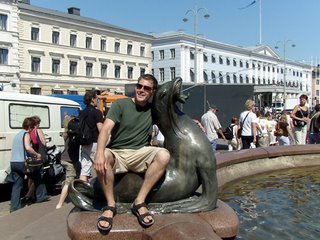
A group of us arose at 5:00 AM on August 17 and began our journey from Wernemunde, Germany to Berlin on our own with no tour. I was going on some knowledge of my previous trip and I wanted to get a closer look rather than a view from the bus. We took the 3 1/2 hour train ride to the city and arrived around 10:00 AM after leaving the small port town around 6:30 AM We started our journey out of the station and crossed over into the Tiergarten where we found our first sight: "Innovative Football Boots," an idea by the Dassler family, 1953, Herzogenaurach. Adi Dassler's new boots provided the German soccer team (football in Europe) with a particularly firm grip on soft, rain-soaked ground. His idea of flexible screw-in studs (deats) revolutionized the game. Soon after the Germans' surprise victory, dubbed the "Miracle of Bern," half the soccer world was using the new-fangled boots.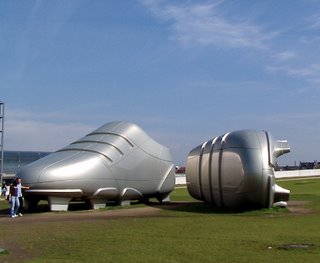 To this day athletes all over the world claim their victories to German sportswear. Nearly half the world's soccer boots are developed in Berlin and 18 of 30 teams competing in the World Cup 2006 use equipment by German manufacturers. Germany has more sports clubs than any other country in the world. This "Innovative Football Boots" sculpture is one of 6 sculptures that comprise the Walk of Ideas celebrating ideas "made in Germany." Further info about these sculptures can be found at www.walk-of-ideas.org. We found 2 other sites where these sculptures were displayed. One was in the Grand Market and Concert Hall where music notes were displayed probably to indicate Germany's role in new ideas in music. Another sculpture we came upon was a stack of books, which must represent all the great German writers. This was displayed in the square of the empty library where the infamous book burning took place. Many of these author's works were burned on this square. Also displayed here the last time I came to Berlin was a circle of German bears that were decorated by each country participating in the World Cup. They were gone today since the entire World Cup craze was over. I was sad to miss them since we only drove by last time.
To this day athletes all over the world claim their victories to German sportswear. Nearly half the world's soccer boots are developed in Berlin and 18 of 30 teams competing in the World Cup 2006 use equipment by German manufacturers. Germany has more sports clubs than any other country in the world. This "Innovative Football Boots" sculpture is one of 6 sculptures that comprise the Walk of Ideas celebrating ideas "made in Germany." Further info about these sculptures can be found at www.walk-of-ideas.org. We found 2 other sites where these sculptures were displayed. One was in the Grand Market and Concert Hall where music notes were displayed probably to indicate Germany's role in new ideas in music. Another sculpture we came upon was a stack of books, which must represent all the great German writers. This was displayed in the square of the empty library where the infamous book burning took place. Many of these author's works were burned on this square. Also displayed here the last time I came to Berlin was a circle of German bears that were decorated by each country participating in the World Cup. They were gone today since the entire World Cup craze was over. I was sad to miss them since we only drove by last time.
We continued on our journey to the Brandenburg Gate.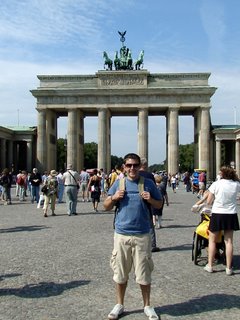 This popular gate was an icon of the Berlin wall. On one side is East Berlin and on the other is the Tiergarten in West Berlin. Anyone wishing to pass through east and west had to stop at the gate first as a checkpoint. We took a journey into town to see a piece of the Berlin Wall at the Topography of Terror. The Berlin Wall was a worldwide symbol for the division of Germany after WWII and for the injustice and inhumanity of the communist system. Construction began on August 13, 1961 on the orders of the GDR (German Democratic Republic) leadership. It was hardly Democratic under this dictatorship. It formed a 93-mile barrier sealing off East Berlin and East Germany from West Berlin. It was built in 2 sections. An anchor wall and "hinterland wall," a border strip with service road, watchtowers and barrier fortifications. Over 150 people were shot down by GDR while attempting to cross. The impending collapse of the Soviet empire and the rapid growth of the GDR protest movement led to the opening of the wall on November 9, 1989. Soon after the first sections of the barrier were torn down. The districts of Mitte (East) and Kreuzberg (West) have been preserved retaining all traces of destruction that occurred during the transitional period and placed under protection as a historical monument.
This popular gate was an icon of the Berlin wall. On one side is East Berlin and on the other is the Tiergarten in West Berlin. Anyone wishing to pass through east and west had to stop at the gate first as a checkpoint. We took a journey into town to see a piece of the Berlin Wall at the Topography of Terror. The Berlin Wall was a worldwide symbol for the division of Germany after WWII and for the injustice and inhumanity of the communist system. Construction began on August 13, 1961 on the orders of the GDR (German Democratic Republic) leadership. It was hardly Democratic under this dictatorship. It formed a 93-mile barrier sealing off East Berlin and East Germany from West Berlin. It was built in 2 sections. An anchor wall and "hinterland wall," a border strip with service road, watchtowers and barrier fortifications. Over 150 people were shot down by GDR while attempting to cross. The impending collapse of the Soviet empire and the rapid growth of the GDR protest movement led to the opening of the wall on November 9, 1989. Soon after the first sections of the barrier were torn down. The districts of Mitte (East) and Kreuzberg (West) have been preserved retaining all traces of destruction that occurred during the transitional period and placed under protection as a historical monument. 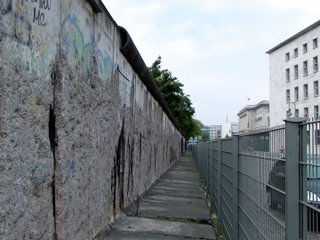 The piece of the wall I saw was kept as a document both of the inhumanity of the border and how it was overcome. The wall will form the north portion of the Topography of Terror, a museum to be built with the history behind the wall. This original open exhibit opened in 1987 n the occasion of the 750th anniversary of the city of Berlin. Onward to Friederichstrausse, which was one of the 7 inner-city border crossings set up. Today it has a special place of remembrance for people all over the world. Like the Berlin Wall, this former crossing symbolizes East Germany's brutal border regime. Under the name given to it by the Allied Forces, "Checkpoint Charlie" is also a symbol of the defense of western democracy. It was in the center of the Iron Curtain, and the border crossing was the scene of the direct confrontation in Europe between the superpowers, the USA and the Soviet Union. We made our way back to the train station after eating lunch at "Snackpoint Charlie" (how commercial things become) up Friederichstrausse to the Grand Market and Concert Hall. Here we found another one of those sculptures celebrating German ideas.
The piece of the wall I saw was kept as a document both of the inhumanity of the border and how it was overcome. The wall will form the north portion of the Topography of Terror, a museum to be built with the history behind the wall. This original open exhibit opened in 1987 n the occasion of the 750th anniversary of the city of Berlin. Onward to Friederichstrausse, which was one of the 7 inner-city border crossings set up. Today it has a special place of remembrance for people all over the world. Like the Berlin Wall, this former crossing symbolizes East Germany's brutal border regime. Under the name given to it by the Allied Forces, "Checkpoint Charlie" is also a symbol of the defense of western democracy. It was in the center of the Iron Curtain, and the border crossing was the scene of the direct confrontation in Europe between the superpowers, the USA and the Soviet Union. We made our way back to the train station after eating lunch at "Snackpoint Charlie" (how commercial things become) up Friederichstrausse to the Grand Market and Concert Hall. Here we found another one of those sculptures celebrating German ideas.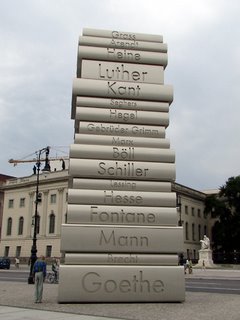 I'm always baffled at the architecture in these ports and this square was no exception. The history here is so rich. We continued on to University Square at Humboldt University where the empty library resides. Here was the place where books were burned. A quote that lies on the ground near the sight of the mounds of books that were burned read something to the order of "he who burns books will burn people." I believe we overheard the tour guide say that a famous writer made this comment before WWII and later had to throw his OWN book in the burning pile. How awful. After a long day of sightseeing and walking, we headed back on the train for another 3 1/2 hour trip.
I'm always baffled at the architecture in these ports and this square was no exception. The history here is so rich. We continued on to University Square at Humboldt University where the empty library resides. Here was the place where books were burned. A quote that lies on the ground near the sight of the mounds of books that were burned read something to the order of "he who burns books will burn people." I believe we overheard the tour guide say that a famous writer made this comment before WWII and later had to throw his OWN book in the burning pile. How awful. After a long day of sightseeing and walking, we headed back on the train for another 3 1/2 hour trip. 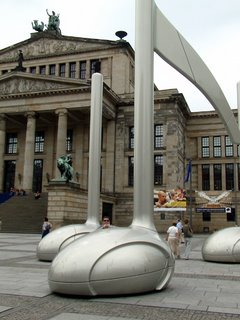 Another sight seen and pure exhaustion culminated.
Another sight seen and pure exhaustion culminated.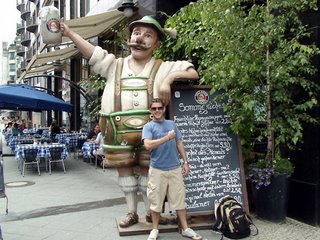
Upon my return I received an e-mail from my company giving me an offer for yet another worldly adventure. I will begin rehearsing in November for Holland America's Prinsendam. It's the smallest ship in the fleet, but it sees the world. Literally. The Grand World Voyage this year is being done on the Amsterdam and I was told I'd possibly be swapping ships mid-contract to vary the shows a little. Our cast will switch ships with the Amsterdam and then go back to the Prinsendam in Europe. If this plan becomes solid (the itinerary portion and swapping), I'll see 3/4 of the entire continent of South America and a tip of Antarctica, Australia, China, Indonesia, Malaysia, India, and Europe all over again with side trips to NYC and Florida. In one contract, I'll see all SEVEN continents of the world and I think that's amazing! Even if the swapping doesn't take place, I'll still see ALL of South America, the tip of Antarctica, and re-visit Europe. I'm excited for this last voyage, but then again who knows. I may not be done yet again who knows. I may not be done yet.

Helsinki, Finland (originally founded by the Swedes in 1550 by Gustav Vasa). I've seen it now at least 4 times on this Baltic cruise. It's normally a day of leisure and occasionally exploration. Over these 4 visits, I've seen quite a bit and just thought I'd summarize. It's the land of Santa Claus. Lapland in northern Helsinki seems to be a popular tour running for about $700 since it involves a flight to the Arctic Circle. Lapland is about 1/3 of Finland itself and is the land of the midnight sun. Someday I'd like to visit this place JUST to see it.
 Santa Claus is the icon here because of the reindeer. Yes folks, reindeer. The Lapps raise them up here and these Lapps are most famous for their traditional garb. One day, I do plan to make that North Pole visit and relive my childhood fantasy of meeting the REAL Santa Claus (or at least a Lapp dressed in traditional garb with a few reindeer). We dock in Helsinki, which is Finland's capital since 1812. The southern coast of Finland is the most populated, industrialized and the richest part of the country. Its Russian neighbor derived its very shape and form. Following a devastating fire in 1808 and its appointment as the capital in 1812, Helsinki was rebuilt with wide streets and neoclassical brick buildings modeled after the Russian capital of St. Petersburg.
Santa Claus is the icon here because of the reindeer. Yes folks, reindeer. The Lapps raise them up here and these Lapps are most famous for their traditional garb. One day, I do plan to make that North Pole visit and relive my childhood fantasy of meeting the REAL Santa Claus (or at least a Lapp dressed in traditional garb with a few reindeer). We dock in Helsinki, which is Finland's capital since 1812. The southern coast of Finland is the most populated, industrialized and the richest part of the country. Its Russian neighbor derived its very shape and form. Following a devastating fire in 1808 and its appointment as the capital in 1812, Helsinki was rebuilt with wide streets and neoclassical brick buildings modeled after the Russian capital of St. Petersburg.  Senate Square is dominated by the recently renovated Tuomiokirkko, which is now mostly used for exhibitions. It stands on a platform above the square and has within its architecture the glories of ancient Greek and Roman influences. It's quite the sight to see among the hip shops that comprise the entire area.
Senate Square is dominated by the recently renovated Tuomiokirkko, which is now mostly used for exhibitions. It stands on a platform above the square and has within its architecture the glories of ancient Greek and Roman influences. It's quite the sight to see among the hip shops that comprise the entire area.  Malls, pubs, restaurants, and trendy hangouts dominate the new city.
Malls, pubs, restaurants, and trendy hangouts dominate the new city.  Down the street and east is the Russian Orthodox Upensky Cathedral. You can see this structure from the Esplanadi sitting high up on it's perch just past the open market by the water. The Esplanadi is the hangout area. There are festivals in the park that runs down the middle of two streets. On either side are various street cafes, restaurants, pubs, and trendy stores. At the end of the boulevard is an open-air market selling anything from fresh vegetables and meats to trinkets and souvenirs. One day I took a walk around the great park that sits behind the train station here and the people are just so care free. It was the middle of the week and the middle of the day and people were on the lawns sunbathing and reading books. How do they do it? I also ventured off with a group to Temppeliaaukio Church (or the Church in a Rock).
Down the street and east is the Russian Orthodox Upensky Cathedral. You can see this structure from the Esplanadi sitting high up on it's perch just past the open market by the water. The Esplanadi is the hangout area. There are festivals in the park that runs down the middle of two streets. On either side are various street cafes, restaurants, pubs, and trendy stores. At the end of the boulevard is an open-air market selling anything from fresh vegetables and meats to trinkets and souvenirs. One day I took a walk around the great park that sits behind the train station here and the people are just so care free. It was the middle of the week and the middle of the day and people were on the lawns sunbathing and reading books. How do they do it? I also ventured off with a group to Temppeliaaukio Church (or the Church in a Rock).  It was built into solid rock and consecrated in 1969. It's superb acoustics allow it to be used for many great concerts. About 90% of these buildings were built after 1920 due to the fire and the harsh struggles between Sweden and Russia. Yet another beautiful place to take a casual stroll and let the woes of the world roll off, as most of these people seem to be doing in the parks.
It was built into solid rock and consecrated in 1969. It's superb acoustics allow it to be used for many great concerts. About 90% of these buildings were built after 1920 due to the fire and the harsh struggles between Sweden and Russia. Yet another beautiful place to take a casual stroll and let the woes of the world roll off, as most of these people seem to be doing in the parks. 
A group of us arose at 5:00 AM on August 17 and began our journey from Wernemunde, Germany to Berlin on our own with no tour. I was going on some knowledge of my previous trip and I wanted to get a closer look rather than a view from the bus. We took the 3 1/2 hour train ride to the city and arrived around 10:00 AM after leaving the small port town around 6:30 AM We started our journey out of the station and crossed over into the Tiergarten where we found our first sight: "Innovative Football Boots," an idea by the Dassler family, 1953, Herzogenaurach. Adi Dassler's new boots provided the German soccer team (football in Europe) with a particularly firm grip on soft, rain-soaked ground. His idea of flexible screw-in studs (deats) revolutionized the game. Soon after the Germans' surprise victory, dubbed the "Miracle of Bern," half the soccer world was using the new-fangled boots.
 To this day athletes all over the world claim their victories to German sportswear. Nearly half the world's soccer boots are developed in Berlin and 18 of 30 teams competing in the World Cup 2006 use equipment by German manufacturers. Germany has more sports clubs than any other country in the world. This "Innovative Football Boots" sculpture is one of 6 sculptures that comprise the Walk of Ideas celebrating ideas "made in Germany." Further info about these sculptures can be found at www.walk-of-ideas.org. We found 2 other sites where these sculptures were displayed. One was in the Grand Market and Concert Hall where music notes were displayed probably to indicate Germany's role in new ideas in music. Another sculpture we came upon was a stack of books, which must represent all the great German writers. This was displayed in the square of the empty library where the infamous book burning took place. Many of these author's works were burned on this square. Also displayed here the last time I came to Berlin was a circle of German bears that were decorated by each country participating in the World Cup. They were gone today since the entire World Cup craze was over. I was sad to miss them since we only drove by last time.
To this day athletes all over the world claim their victories to German sportswear. Nearly half the world's soccer boots are developed in Berlin and 18 of 30 teams competing in the World Cup 2006 use equipment by German manufacturers. Germany has more sports clubs than any other country in the world. This "Innovative Football Boots" sculpture is one of 6 sculptures that comprise the Walk of Ideas celebrating ideas "made in Germany." Further info about these sculptures can be found at www.walk-of-ideas.org. We found 2 other sites where these sculptures were displayed. One was in the Grand Market and Concert Hall where music notes were displayed probably to indicate Germany's role in new ideas in music. Another sculpture we came upon was a stack of books, which must represent all the great German writers. This was displayed in the square of the empty library where the infamous book burning took place. Many of these author's works were burned on this square. Also displayed here the last time I came to Berlin was a circle of German bears that were decorated by each country participating in the World Cup. They were gone today since the entire World Cup craze was over. I was sad to miss them since we only drove by last time. We continued on our journey to the Brandenburg Gate.
 This popular gate was an icon of the Berlin wall. On one side is East Berlin and on the other is the Tiergarten in West Berlin. Anyone wishing to pass through east and west had to stop at the gate first as a checkpoint. We took a journey into town to see a piece of the Berlin Wall at the Topography of Terror. The Berlin Wall was a worldwide symbol for the division of Germany after WWII and for the injustice and inhumanity of the communist system. Construction began on August 13, 1961 on the orders of the GDR (German Democratic Republic) leadership. It was hardly Democratic under this dictatorship. It formed a 93-mile barrier sealing off East Berlin and East Germany from West Berlin. It was built in 2 sections. An anchor wall and "hinterland wall," a border strip with service road, watchtowers and barrier fortifications. Over 150 people were shot down by GDR while attempting to cross. The impending collapse of the Soviet empire and the rapid growth of the GDR protest movement led to the opening of the wall on November 9, 1989. Soon after the first sections of the barrier were torn down. The districts of Mitte (East) and Kreuzberg (West) have been preserved retaining all traces of destruction that occurred during the transitional period and placed under protection as a historical monument.
This popular gate was an icon of the Berlin wall. On one side is East Berlin and on the other is the Tiergarten in West Berlin. Anyone wishing to pass through east and west had to stop at the gate first as a checkpoint. We took a journey into town to see a piece of the Berlin Wall at the Topography of Terror. The Berlin Wall was a worldwide symbol for the division of Germany after WWII and for the injustice and inhumanity of the communist system. Construction began on August 13, 1961 on the orders of the GDR (German Democratic Republic) leadership. It was hardly Democratic under this dictatorship. It formed a 93-mile barrier sealing off East Berlin and East Germany from West Berlin. It was built in 2 sections. An anchor wall and "hinterland wall," a border strip with service road, watchtowers and barrier fortifications. Over 150 people were shot down by GDR while attempting to cross. The impending collapse of the Soviet empire and the rapid growth of the GDR protest movement led to the opening of the wall on November 9, 1989. Soon after the first sections of the barrier were torn down. The districts of Mitte (East) and Kreuzberg (West) have been preserved retaining all traces of destruction that occurred during the transitional period and placed under protection as a historical monument.  The piece of the wall I saw was kept as a document both of the inhumanity of the border and how it was overcome. The wall will form the north portion of the Topography of Terror, a museum to be built with the history behind the wall. This original open exhibit opened in 1987 n the occasion of the 750th anniversary of the city of Berlin. Onward to Friederichstrausse, which was one of the 7 inner-city border crossings set up. Today it has a special place of remembrance for people all over the world. Like the Berlin Wall, this former crossing symbolizes East Germany's brutal border regime. Under the name given to it by the Allied Forces, "Checkpoint Charlie" is also a symbol of the defense of western democracy. It was in the center of the Iron Curtain, and the border crossing was the scene of the direct confrontation in Europe between the superpowers, the USA and the Soviet Union. We made our way back to the train station after eating lunch at "Snackpoint Charlie" (how commercial things become) up Friederichstrausse to the Grand Market and Concert Hall. Here we found another one of those sculptures celebrating German ideas.
The piece of the wall I saw was kept as a document both of the inhumanity of the border and how it was overcome. The wall will form the north portion of the Topography of Terror, a museum to be built with the history behind the wall. This original open exhibit opened in 1987 n the occasion of the 750th anniversary of the city of Berlin. Onward to Friederichstrausse, which was one of the 7 inner-city border crossings set up. Today it has a special place of remembrance for people all over the world. Like the Berlin Wall, this former crossing symbolizes East Germany's brutal border regime. Under the name given to it by the Allied Forces, "Checkpoint Charlie" is also a symbol of the defense of western democracy. It was in the center of the Iron Curtain, and the border crossing was the scene of the direct confrontation in Europe between the superpowers, the USA and the Soviet Union. We made our way back to the train station after eating lunch at "Snackpoint Charlie" (how commercial things become) up Friederichstrausse to the Grand Market and Concert Hall. Here we found another one of those sculptures celebrating German ideas. I'm always baffled at the architecture in these ports and this square was no exception. The history here is so rich. We continued on to University Square at Humboldt University where the empty library resides. Here was the place where books were burned. A quote that lies on the ground near the sight of the mounds of books that were burned read something to the order of "he who burns books will burn people." I believe we overheard the tour guide say that a famous writer made this comment before WWII and later had to throw his OWN book in the burning pile. How awful. After a long day of sightseeing and walking, we headed back on the train for another 3 1/2 hour trip.
I'm always baffled at the architecture in these ports and this square was no exception. The history here is so rich. We continued on to University Square at Humboldt University where the empty library resides. Here was the place where books were burned. A quote that lies on the ground near the sight of the mounds of books that were burned read something to the order of "he who burns books will burn people." I believe we overheard the tour guide say that a famous writer made this comment before WWII and later had to throw his OWN book in the burning pile. How awful. After a long day of sightseeing and walking, we headed back on the train for another 3 1/2 hour trip.  Another sight seen and pure exhaustion culminated.
Another sight seen and pure exhaustion culminated.
Upon my return I received an e-mail from my company giving me an offer for yet another worldly adventure. I will begin rehearsing in November for Holland America's Prinsendam. It's the smallest ship in the fleet, but it sees the world. Literally. The Grand World Voyage this year is being done on the Amsterdam and I was told I'd possibly be swapping ships mid-contract to vary the shows a little. Our cast will switch ships with the Amsterdam and then go back to the Prinsendam in Europe. If this plan becomes solid (the itinerary portion and swapping), I'll see 3/4 of the entire continent of South America and a tip of Antarctica, Australia, China, Indonesia, Malaysia, India, and Europe all over again with side trips to NYC and Florida. In one contract, I'll see all SEVEN continents of the world and I think that's amazing! Even if the swapping doesn't take place, I'll still see ALL of South America, the tip of Antarctica, and re-visit Europe. I'm excited for this last voyage, but then again who knows. I may not be done yet again who knows. I may not be done yet.

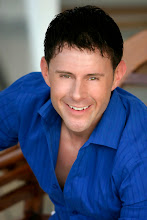

0 Comments:
Post a Comment
<< Home